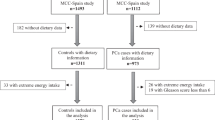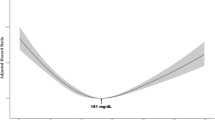Abstract
It has been hypothesized that blood lipid levels might be associated with prostate cancer risk. The aim of the present study was to evaluate the association between serum total cholesterol, high-density lipoprotein (HDL) cholesterol, low-density lipoprotein (LDL) cholesterol, triglycerides and prostate cancer risk in a cohort study among 2842 Dutch men. By the end of follow-up, 64 incident cases of prostate cancer were identified. Serum total cholesterol, HDL cholesterol, LDL cholesterol and triglycerides were evaluated as potential risk factors for prostate cancer using multivariable Cox proportional hazards regression models. These analyses were restricted to men who never used cholesterol-lowering drugs (2118 men, 43 cases). Higher total and higher LDL cholesterol were significantly associated with an increased risk of prostate cancer (hazards ratios (HR) and 95% confidence interval (CI) per mmol l−1 were 1.39 (95% CI 1.03–1.88) and 1.42 (95% CI 1.00–2.02), respectively). Similar results were observed for aggressive prostate cancer, whereas for non-aggressive prostate cancer a significant association with HDL cholesterol was found (HR 4.28, 95% CI 1.17–15.67). The results of this study suggest that blood lipid levels may influence risk of prostate cancer. However, the exact roles of different cholesterol fractions on prostate cancer aggressiveness should be further evaluated.
This is a preview of subscription content, access via your institution
Access options
Subscribe to this journal
Receive 4 print issues and online access
$259.00 per year
only $64.75 per issue
Buy this article
- Purchase on Springer Link
- Instant access to full article PDF
Prices may be subject to local taxes which are calculated during checkout
Similar content being viewed by others
References
Hammarsten J, Hogstedt B . Clinical, haemodynamic, anthropometric, metabolic and insulin profile of men with high-stage and high-grade clinical prostate cancer. Blood Press 2004; 13: 47–55.
Wuermli L, Joerger M, Henz S, Schmid HP, Riesen WF, Thomas G et al. Hypertriglyceridemia as a possible risk factor for prostate cancer. Prostate Cancer Prostatic Dis 2005; 8: 316–320.
Magura L, Blanchard R, Hope B, Beal JR, Schwartz GG, Sahmoun AE . Hypercholesterolemia and prostate cancer: a hospital-based case-control study. Cancer Causes Control 2008; 19: 1259–1266.
Farwell WR, D’Avolio LW, Scranton RE, Lawler EV, Gaziano JM . Statins and prostate cancer diagnosis and grade in a veterans population. J Natl Cancer Inst 2011; 103: 005–092.
Bravi F, Scotti L, Bosetti C, Talamini R, Negri E, Montella M et al. Self-reported history of hypercholesterolaemia and gallstones and the risk of prostate cancer. Ann Oncol 2006; 17: 1014–1017.
Platz EA, Clinton SK, Giovannucci E . Association between plasma cholesterol and prostate cancer in the PSA era. Int J Cancer 2008; 123: 1693–1698.
Mondul AM, Clipp SL, Helzlsouer KJ, Platz EA . Association between plasma total cholesterol concentration and incident prostate cancer in the CLUE II cohort. Cancer Causes Control 2010; 21: 61–68.
Platz EA, Till C, Goodman PJ, Parnes HL, Figg WD, Albanes D et al. Men with low serum cholesterol have a lower risk of high-grade prostate cancer in the placebo arm of the prostate cancer prevention trial. Cancer Epidemiol Biomarkers Prev 2009; 18: 2807–2813.
Martin RM, Vatten L, Gunnell D, Romundstad P, Nilsen TI . Components of the metabolic syndrome and risk of prostate cancer: the HUNT 2 cohort, Norway. Cancer Causes Control 2009; 20: 1181–1192.
Steenland K, Nowlin S, Palu S . Cancer incidence in the National Health and Nutrition Survey I. Follow-up data: diabetes, cholesterol, pulse and physical activity. Cancer Epidemiol Biomarkers Prev 1995; 4: 807–811.
Schatzkin A, Hoover RN, Taylor PR, Ziegler RG, Carter CL, Albanes D et al. Site-specific analysis of total serum cholesterol and incident cancer in the National Health and Nutrition Examination Survey I Epidemiologic Follow-up Study. Cancer Res 1988; 48: 452–458.
Tulinius H, Sigfusson N, Sigvaldason H, Bjarnadottir K, Tryggvadottir L . Risk factors for malignant diseases: a cohort study on a population of 22,946 Icelanders. Cancer Epidemiol Biomarkers Prev 1997; 6: 863–873.
Hiatt RA, Fireman BH . Serum cholesterol and the incidence of cancer in a large cohort. J Chronic Dis 1986; 39: 861–870.
Thompson MM, Garland C, Barrett-Connor E, Khaw KT, Friedlander NJ, Wingard DL . Heart disease risk factors, diabetes, and prostatic cancer in an adult community. Am J Epidemiol 1989; 129: 511–517.
Ahn J, Lim U, Weinstein SJ, Schatzkin A, Hayes RB, Virtamo J et al. Prediagnostic total and high-density lipoprotein cholesterol and risk of cancer. Cancer Epidemiol Biomarkers Prev 2009; 18: 2814–2821.
Knekt P, Reunanen A, Aromaa A, Heliovaara M, Hakulinen T, Hakama M . Serum cholesterol and risk of cancer in a cohort of 39,000 men and women. J Clin Epidemiol 1988; 41: 519–530.
Morris DL, Borhani NO, Fitzsimons E, Hardy RJ, Hawkins CM, Kraus JF et al. Serum cholesterol and cancer in the hypertension detection and follow-up program. Cancer 1983; 52: 1754–1759.
Platz EA, Leitzmann MF, Visvanathan K, Rimm EB, Stampfer MJ, Willett WC et al. Statin drugs and risk of advanced prostate cancer. J Natl Cancer Inst 2006; 98: 1819–1825.
Murtola TJ, Tammela TL, Lahtela J, Auvinen A . Cholesterol-lowering drugs and prostate cancer risk: a population-based case-control study. Cancer Epidemiol Biomarkers Prev 2007; 16: 2226–2232.
Flick ED, Habel LA, Chan KA, Van Den Eeden SK, Quinn VP, Haque R et al. Statin use and risk of prostate cancer in the California Men's Health Study cohort. Cancer Epidemiol Biomarkers Prev 2007; 16: 2218–2225.
Jacobs EJ, Rodriguez C, Bain EB, Wang Y, Thun MJ, Calle EE . Cholesterol-lowering drugs and advanced prostate cancer incidence in a large US cohort. Cancer Epidemiol Biomarkers Prev 2007; 16: 2213–2217.
Bonovas S, Filioussi K, Sitaras NM . Statin use and the risk of prostate cancer: a meta-analysis of 6 randomized clinical trials and 13 observational studies. Int J Cancer 2008; 123: 899–904.
Demierre MF, Higgins PD, Gruber SB, Hawk E, Lippman SM . Statins and cancer prevention. Nat Rev Cancer 2005; 5: 930–942.
Hamilton RJ, Freedland SJ . Rationale for statins in the chemoprevention of prostate cancer. Curr Urol Rep 2008; 9: 189–196.
Friedewald WT, Levy RI, Fredrickson DS . Estimation of the concentration of low-density lipoprotein cholesterol in plasma, without use of the preparative ultracentrifuge. Clin Chem 1972; 18: 499–502.
Greene FL, Page DL, Fleming ID, Fritz A, Balch CM, Haller DG et al. AJCC Cancer Staging Manual, 6th ed Springer-Verlag: New York, 2002.
Gong Z, Neuhouser ML, Goodman PJ, Albanes D, Chi C, Hsing AW et al. Obesity, diabetes, and risk of prostate cancer: results from the prostate cancer prevention trial. Cancer Epidemiol Biomarkers Prev 2006; 15: 1977–1983.
Bostwick DG, Burke HB, Djakiew D, Euling S, Ho SM, Landolph J et al. Human prostate cancer risk factors. Cancer 2004; 101 (10 Suppl): 2371–2490.
Nordestgaard BG, Benn M . Fasting and nonfasting LDL cholesterol: to measure or calculate? Clin Chem 2009; 55: 845–847.
Langsted A, Freiberg JJ, Nordestgaard BG . Fasting and nonfasting lipid levels: influence of normal food intake on lipids, lipoproteins, apolipoproteins, and cardiovascular risk prediction. Circulation 2008; 118: 2047–2056.
Sniderman AD, Blank D, Zakarian R, Bergeron J, Frohlich J . Triglycerides and small dense LDL: the twin Achilles heels of the Friedewald formula. Clin Biochem 2003; 36: 499–504.
Davidson MH, Toth PP, Maki KC, Gotto AM . High-density lipoproteins. In: Cannon CP (ed). Therapeutic Lipidology. Humana Press: Totowa, New Jersey, 2007; pp 159–199.
Simons K, Ikonen E . Functional rafts in cell membranes. Nature 1997; 387: 569–572.
Hager MH, Solomon KR, Freeman MR . The role of cholesterol in prostate cancer. Curr Opin Clin Nutr Metab Care 2006; 9: 379–385.
Freeman MR, Solomon KR . Cholesterol and prostate cancer. J Cell Biochem 2004; 91: 54–69.
Di Vizio D, Solomon KR, Freeman MR . Cholesterol and cholesterol-rich membranes in prostate cancer: an update. Tumori 2008; 94: 633–639.
Zhuang L, Lin J, Lu ML, Solomon KR, Freeman MR . Cholesterol-rich lipid rafts mediate akt-regulated survival in prostate cancer cells. Cancer Res 2002; 62: 2227–2231.
Kim J, Adam RM, Solomon KR, Freeman MR . Involvement of cholesterol-rich lipid rafts in interleukin-6-induced neuroendocrine differentiation of LNCaP prostate cancer cells. Endocrinology 2004; 145: 613–619.
Locke JA, Guns ES, Lubik AA, Adomat HH, Hendy SC, Wood CA et al. Androgen levels increase by intratumoral de novo steroidogenesis during progression of castration-resistant prostate cancer. Cancer Res 2008; 68: 6407–6415.
Dillard PR, Lin MF, Khan SA . Androgen-independent prostate cancer cells acquire the complete steroidogenic potential of synthesizing testosterone from cholesterol. Mol Cell Endocrinol 2008; 295: 115–120.
Acknowledgements
DEG Kok was supported by a research grant (2005/63) from the World Cancer Research Fund.
Author information
Authors and Affiliations
Corresponding author
Ethics declarations
Competing interests
The authors declare no conflict of interest.
Rights and permissions
About this article
Cite this article
Kok, D., van Roermund, J., Aben, K. et al. Blood lipid levels and prostate cancer risk; a cohort study. Prostate Cancer Prostatic Dis 14, 340–345 (2011). https://doi.org/10.1038/pcan.2011.30
Received:
Revised:
Accepted:
Published:
Issue Date:
DOI: https://doi.org/10.1038/pcan.2011.30
Keywords
This article is cited by
-
Serum cholesterol and prostate cancer risk in the Finnish randomized study of screening for prostate cancer
Prostate Cancer and Prostatic Diseases (2019)
-
Cholesterol and prostate cancer risk: a long-term prospective cohort study
BMC Cancer (2016)
-
Association of serum lipid levels and prostate cancer severity among Hispanic Puerto Rican men
Lipids in Health and Disease (2015)
-
Effect of metabolic syndrome and its components on prostate cancer risk: Meta-analysis
Journal of Endocrinological Investigation (2013)
-
Targeting tumor cell metabolism with statins
Oncogene (2012)



